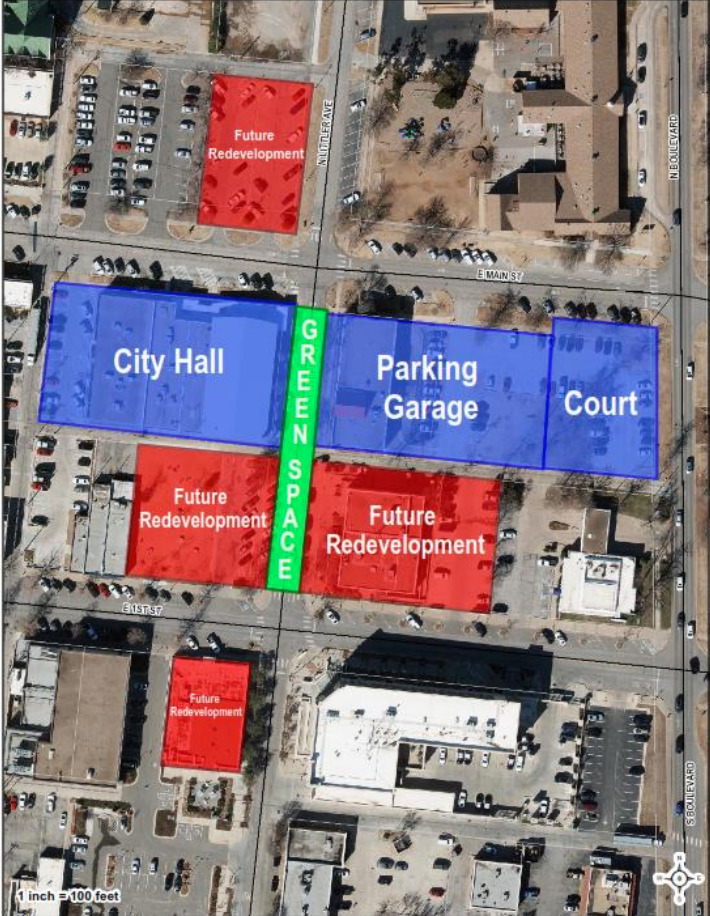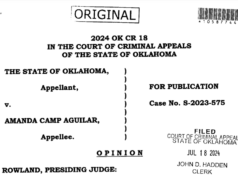

Once Edmond’s $44 million city center complex is complete and employees have vacated the old municipal offices downtown, a TIF district could be implemented over those vacant parcels to stimulate private development, Randy Entz, the city’s director of planning and zoning, recently told members of the Edmond Alliance at a luncheon.
Later in the Oct. 18 luncheon, Entz told the group of about 50 developers that the city may use eminent domain to secure property in downtown for a commuter rail station.
According to its website, the Edmond Alliance is a 501(c)(4) organization with dues-paying members that intends to support responsible growth in City of Edmond projects, provide a “voice of truth” regarding the real estate and construction industries, financially support candidates for Edmond City Council and campaign for ballot measures that align with the group’s interests.
Real estate developers and former Edmond City Council members Josh Moore and David Chapman serve on the Edmond Alliance’s board, alongside attorney Todd McKinnis and developers Matthew Myers and Clay Coldiron.
In what was the Edmond Alliance’s second quarterly luncheon at the KickingBird Banquet Hall since the group’s inception, McKinnis opened the day with brief remarks on the topics that would be discussed, before passing the microphone to Moore.
“With each of our quarterly luncheons, we want to have a different theme. So, the idea today is downtown Edmond,” McKinnis said. “Randy is going to give us a little update on what got [downtown Edmond] to where it is if you look back just five or 10 years, and what might be the obstacles to get us where it might be headed in the future.”
Moore spoke on a variety of topics related to real estate and business in Edmond, and he also noted that the Edmond Alliance has posted a TIF explainer document on its website.
“That’s a goal of ours — to educate the community on things that are going on,” Moore said.
Second TIF district has only been discussed by city staff

Implementation of a second TIF district in downtown has yet to be discussed at a public meeting. Entz told members of the dues-paying group Oct. 18 that the city plans to create a TIF district to help spur private development on the lots that currently feature the city council chambers, the City First building, Littler Lawn and the parking lot across the street from Russell Dougherty Elementary School. Those buildings’ offices will be moved into the new city center complex, which is expected to be completed in spring 2025.
“We don’t need it anymore as the city,” Entz said of the property. “So, our thought with the city is, why don’t we turn that back into private sector’s hands and get it active?”
Entz said the city is planning to issue a request for proposal for the roughly 2 1/2 acres of land down Littler Avenue between First Street and Main Street.
“That conversation has yet to happen, but (we want it) to become something else,” Entz said of the parcels. “Either office, residential, boutique hotels — something different than a surface parking lot, for sure.”
Entz then said the city is planning to pursue approval of a tax increment finance district over the properties.
“What we plan on doing is carving these parcels out for their own TIF district,” Entz said. “We’re three or four years in on our other one. It gives us more opportunity to focus projects on these areas to help improve as well.”
Reached for comment Tuesday, Entz said plans surrounding a second TIF district are still at a “staff level” and have yet to be presented before any city board or commission.
“The direction has been, to date, that we were going to redevelop that vacated property, and one of the tools we could use to help facilitate that development is create a new TIF over just that property,” he said. “Nothing official has been done on that yet. None of the legwork or anything like that. That is all still to come officially.”
While TIF districts are implemented differently across the country, they are a tool used by municipalities to encourage private development and stimulate infrastructure improvements in targeted areas. Some TIFs involve sales taxes and other involve property taxes, such as the existing downtown Edmond TIF.
When a TIF district is created, the property value of each property within the district — as well as the taxes paid upon those values — are frozen for the life of the district. According to state statute, TIF districts can be implemented for up to 25 years. The city of Edmond’s only TIF district was approved in October 2020 for a term ending June 30, 2039.
Any increased property value and accompanying property tax revenue brought by development projects in a TIF district go back to the city, which then pays the developer over time for the project and associated infrastructure improvements pursuant to the development agreement. Depending on the terms of the agreement, some tax revenue can be used to fund other projects or further infrastructure improvements within the TIF district. Properties are assessed on an annual basis by the Oklahoma County Assessor’s Office, and the developers are paid annually by the city.
When a TIF district expires, cities hope the properties represent a new and higher tax base, which means increased property tax revenues will go back to the entities which typically collect those revenues — not the city. In Edmond, those entities are Edmond Public Schools, Oklahoma County, Francis Tuttle Technology Center, the Metropolitan Library System and the Oklahoma City-County Health Department.
Often, TIF districts are established in areas that maintain stagnant property values and where private development alone is less likely without incentive. However, critics of TIF districts argue that they often lack oversight or are unnecessary for desirable areas where private development may naturally occur, such as the downtown area of a city like Edmond.
In response to an records request seeking documents, reports and emails between city staff and members of the Edmond City Council related to a second TIF district, no responsive records were found, according to city clerk Kory Atcuson.
Eminent domain considered for downtown rail station

In fall 2024 or spring 2025, the Regional Transportation Authority of Central Oklahoma is planning to bring a simultaneous vote before Edmond, Oklahoma City and Norman residents to fund a proposed commuter rail project connecting RTA’s member cities. The proposed rail project also includes alternative corridors to Will Rogers World Airport and Tinker Air Force Base.
If each ballot measure in Edmond, OKC and Norman is approved, it could require member cities to raise sales tax rates. According to state law, the RTA can only levy a sales tax within member cities at a maximum rate of 2 percent. No other tax revenue sources from member cities can be used to fund the project, which will largely be backed by federal grants.
In preparation for that vote, RTA is asking for member cities to procure property to be used for train stations constructed by RTA. During the Oct. 18 luncheon, Entz told members of the Edmond Alliance that the city has to be careful where the station will be built.
“The second you put a station down, development happens around it,” Entz said. “So we have to be careful where we put that station because we don’t want our historic fabric torn asunder, but we do want development around it.”
Asked by McKinnis where the station could be located, Entz said the city is preparing to use eminent domain to secure property for the station.
“We’re about to eminent domain some property south of [2nd Street], it will probably be,” Entz said. “We have our final offer to them, but no response yet.”
Asked about the property in question Tuesday, Entz said the city is attempting to piece together enough parcels on the east side of the railroad tracks between 2nd Street and 9th Street for the construction of a station and a platform.
“The city has a little bit of property there, and there is one piece kind of in the middle of it that we don’t control,” Entz said. “We’re in negotiations with that property owner right now.”
Asked whether the city intends to use eminent domain if the owner refuses to sell, Entz said that option is on the table.
“I mean, that’s never our preference,” Entz said. “But the city does always have that ability particularly for something like this — for infrastructure needs.”




















